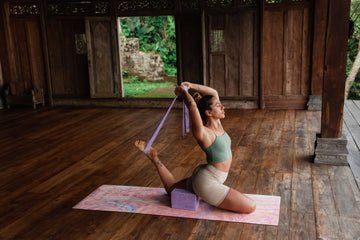Elevate Your Practice: The Transformative Power of Yoga Blocks and Straps
Mar 11, 2024
Embarking on a journey into the world of yoga is a venture onto the path of self-discovery, mindfulness, and holistic well-being. As we navigate through the Asanas and delve into the serenity of each breath, the integration of yoga props helps us to support and deepen our yoga practice.

Far from being mere accessories, props are the tools that make yoga accessible to practitioners of all levels. In this exploration, we unravel the secrets behind the transformative power of yoga props, discovering how they can revolutionize your practice and pave the way to a more fulfilling and enriching yoga experience.
Yoga Blocks: The Cornerstones of Stability
At the heart of stability lies the yoga block. Whether you are a beginner yogi, building the foundation of your practice, or a seasoned yogi seeking alignment perfection, yoga blocks provide the necessary support and length to your practice.

In standing poses they provide extra length in Ardha Chandrasana (half-moon pose), Urdhva Prasarita Eka Padasana (standing splits), Trikonasana (triangle pose), Parivrtta Trikonasana (revolved triangle) and Utthita Parsvakonasana (side-angle pose), by closing the gap between your hands and the floor, and helping you to work towards the full expression of the pose!
Blocks are also an excellent tool to use in Sukhasana (easy pose), or Virasana (Hero’s pose), when sitting on the block the hips are placed above the knees and the pelvis tilts slightly forward, relieving pressure from the lower back. Sitting on a block provides comfort and long lasting support for seated practices such as breathwork or meditation.

When practicing arm balances such as Bakasana (Crane pose) or Kakasana (Crow pose), you can place the block in front of your forehead to catch you in case you fall forward (make sure its a softer, foam block), in Pincha Mayarasua (forearm stand) you can use the yoga block in between the hands and press into the block to stabilize your foundation.
In slower paced practices such as restorative and yin yoga, blocks provide the support you need in order to be able to fully relax into the soothing serenity of the postures. In Kapotasana (pigeon pose) you can place the block underneath the heart, forehead or the hip, in Supta Baddha Konasana (reclined bound angle pose) you can place the blocks underneath outer thighs for support, and in a restorative backbend you can use two blocks to support you as you relax into a sweet heart opening pose.

Yoga blocks can also be a solid tool for creating stability and traction in the lower back, by placing the block underneath the sacrum and walking the shoulders towards the top of the mat in Setu Bandha Sarvāṅgāsana (supported bridge pose). The block helps to create traction for the lumbar spine, and alleviate lower back pain. This is a pose you can also stay in for a while and let the block do the work for you, creating traction in the spine while you breathe and relax.
Yoga blocks are so dynamic, they can be utilized in so many different ways and integrated into every form of yoga. Ultimately, yoga blocks are our friends within the yoga practice, ensuring stability and fostering a sense of confidence and security on the mat, no matter what level or style of yoga!
Straps: Unleashing the Power of Stretch
Another versatile tool to assist in deepening stretches and making seemingly unattainable poses within literal reach is the amazing yoga strap! A yoga strap makes shoulder and hip opening gentle and attainable while you work to open commonly tight areas. From binding in Baddha Konasana (Butterfly pose) to extending your reach in Paschimottanasana (Seated Forward Fold), yoga straps facilitate a gradual and controlled progression, unlocking new dimensions in flexibility and encouraging a sense of accomplishment.

Straps are crucial in shoulder opening, from seated Gomukasana (Cow Faced Pose) to gentle rounds of shoulder openers (with the strap in between your hands and moving the hands up and back), straps are our dearest friends when working to open tight areas in the upper body.

Yoga straps can also be used in reclining poses to open tight hamstrings in Supta Padangusthasana (reclined hand to big toe pose), providing length and a sense of ease when holding the pose for a few breaths. When opening the leg to the side in a common variation of the pose, the strap helps to stabilize the inner groin stretch and makes sure you don’t take it further than your body will allow.

Much like the yoga block, yoga straps are versatile and dynamic! There are endless possibilities when incorporating both props into your practice no matter what style of yoga you love to do! They help us to create length, stability and support as we work to open tight areas of the body, as well as help us to work towards the full expression of a yoga pose. These supportive tools not only aid beginners but also enhance the experience for seasoned practitioners, making yoga a versatile and inclusive practice.
By Alexis Miller, RYT



